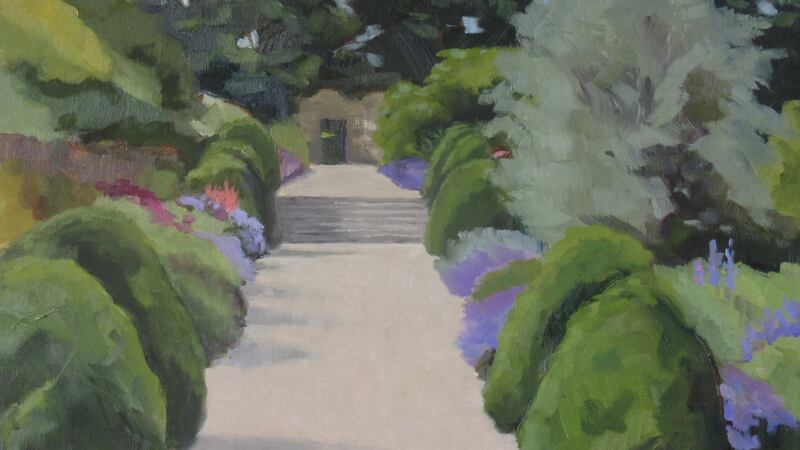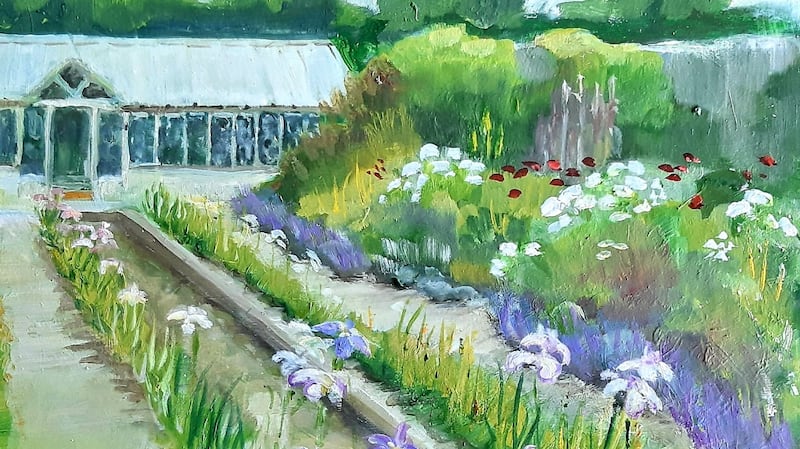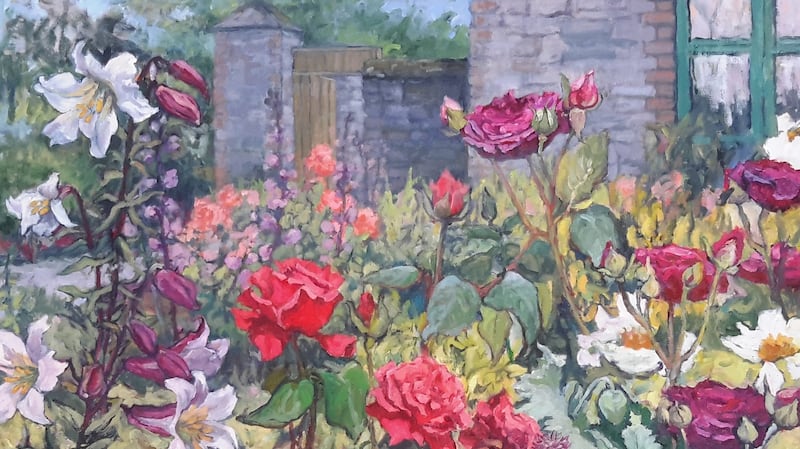A walled garden has a particular mood in the context of an Irish country house garden. Serene and secluded, it can be a place of solace away from the larger landscaped surroundings. A functioning walled garden also has a bountiful mix of flowers, fruit trees, vegetables and herbs which is harvested for use in the kitchen.
Although originally built to create microclimates to grow this produce, many walled gardens fell into disrepair only to be reclaimed and restored decades – and sometimes centuries – later by new owners, state agencies or voluntary organisations.
"There has been a revived interest in walled gardens if you consider the work of the Royal Horticultural Society in the walled gardens at Russborough House in Co Wicklow or the restoration of the walled gardens at Kylemore Abbey in Co Galway and the Colclough walled garden at Tintern Abbey in Co Wexford," says Donough Cahill, executive director of the Irish Georgian Society.
In 2021, the society decided to celebrate such gardens with two exhibitions at their headquarters in City Assembly House, South William Street, Dublin.
The first is Stepping Through the Gate: Inside Ireland’s Walled Gardens with paintings by four female artists – Lesley Fennell, Andrea Jameson, Maria Levinge and Alison Rosse – all of whom are also gardeners in their own Irish country houses.
The second, In Harmony with Nature: The Irish Country House Garden, has been postponed to Spring 2022.
Landscape artists
Robert O'Byrne, curator of both exhibitions – and presenter of two documentaries on Irish Historic Gardens on RTÉ1 on Sunday, September 26th and Sunday, October 3rd at 6.30pm – had the particular task of choosing the artists he felt would be most suitable for the exhibition.
“There are lots of good botanical artists but for this exhibition, I was looking for landscape artists who were also gardeners and who were familiar with walled gardens,” explains O’Byrne, who has written extensively on Irish country houses.
O’Byrne also interviewed each artist in advance of the exhibition for an Irish Georgian Society series available on subscription earlier this year (and available to listen to at the exhibition). In these interviews, the artists described their gardens and what inspired them to paint.
Lesley Fennell, who has created a lovely garden at Burtown House, Co Kildare says she is very drawn to colour.
“I love flowers and gardens and my painting and my gardening are very connected by the energy and magic of the way things grow and the energy of the paint. It’s the combination of those things that interest me.”
For the exhibition, she painted in Ballynure, Co Wicklow, Barmeath, Co Louth, Coolcarrigan, Co Kildare, Heywood, Co Laois and in her own garden at Burtown, Co Kildare.


Alison Rosse, with her husband, Lord Rosse, inherited the responsibility for Birr Castle, Co Offaly the demesne of which includes walled gardens laid out by Lord Rosse’s late parents.
“I surprised myself in that I found it quite difficult to paint walled gardens. Unless you paint into a corner, you’ve got a wall in front of you,” she explains.
However, she overcame her dilemma by painting at quirky angles from a high point in each garden. For the exhibition, she painted at Glin Castle and Kilgobbin, Co Limerick, Anne’s Grove, Co Cork, Birr Castle and Bellefield, Co Offaly, Larchhill, Co Kildare and Cullen, Co Louth.
Source of inspiration
Andrea Jameson who, with her two sisters, maintains a walled garden at Tourin, Co Waterford says she loves where she lives.
“I paint because I want to share the beauty that’s in this little haven. I work outside nearly all the time,” says Jameson.
She finds walled gardens a particular source of inspiration.
“It’s enclosed, comfortable and full of shapes,” she says.
For this exhibition, she painted the walled gardens at Doneraile Court, Co Cork, the Dower House, Rossanagh and Kilmacurragh Gardens in Co Wicklow, Cappoquin House and Lismore Castle in Co Waterford and at her home gardens in Tourin, Co Waterford.
And Maria Levinge, who has established a new garden for herself and her family in Co Wexford, says she loves painting in oil.
“I find walled gardens to be a place of sanctuary and shelter. Yet, in all my walled gardens paintings, there is an escape route,” she says.
Levinge painted the walled gardens in Altamount, Co Carlow, Woodstock, Co Kilkenny, Abbeyleix, Co Laois, Lisadell, Co Sligo, Crom Castle, Co Fermanagh, Enniscoe, Co Mayo and at the Royal Hospital Kilmainham, Dublin.


The catalogue for Stepping Through The Gate: Inside Ireland’s Walled Gardens is also a celebration of all the country houses where the artists did their paintings. Written by O’Byrne, it gives visitors an insight into the history of each property.
And O’Byrne is keen to draw significance from the timing of the exhibition – as the world reeled from the Covid-19 pandemic and the growing climate emergency.
“As we become more conscious of caring for our environment and the benefits of growing our own product and the physical and psychological advantages of engaging with our natural surroundings, the opportunity – the necessity – of cherishing our walled gardens is clear,” he says.
Stepping Through the Gate: Inside Ireland’s Walled Gardens with paintings by four female artists – Lesley Fennell, Andrea Jameson, Maria Levinge and Alison Rosse – runs from September 23rd to November 26th in the Irish Georgian Society, City Assembly House, 58 South William St, Dublin 2
History of Walled Gardens
Walled gardens were first developed as part of Irish country houses in the 17th century. Consider Lismore Castle in Co Waterford (whose walled gardens have recently been wonderfully restored), the walled gardens at the Royal Hospital Kilmainham and the large walled garden at Ballyfin, Co Laois.
Greenhouses built onto the south-facing brick walls in these gardens offered owners opportunities to grow exotic fruits. And fish ponds also provided food for the table. As well as these practical purposes, walled gardens, with their high yew, laurel or beech hedges, also offered privacy and protection from animal or human intruders and were a feature of many smaller houses such as glebes and convents too.
In the second half of the 18th century, Irish country house owners embraced a more natural style of gardens with trees, lakes and large areas of grass. For many gardens, this signalled the demise of the walled garden next to the house.
Instead, high walled gardens with raised beds for growing fruit, vegetables and flowers and an orchard of fruit trees were sited close to the kitchen yet not within sight of the Big House.


Walled gardens came back into vogue again particularly for growing flowers but, according to O’Byrne, by the middle of the 20th century, only a handful of country house walled gardens retained their original glory.
However in the last two decades, walled gardens in both privately-owned and state-managed country houses have benefited from considerable conservation and restoration, according to historic garden consultant, Finola Reid.
These include the walled gardens at Mount Stewart and Hillsborough Castle in Co Down, the walled gardens at Kylemore Abbey, Co Galway and the walled garden at Russborough House in Co Wicklow.
Garden historian, Terence Reeves-Smith has estimated that up to 8,000 walled gardens remain in Ireland in various states of repair and use.













